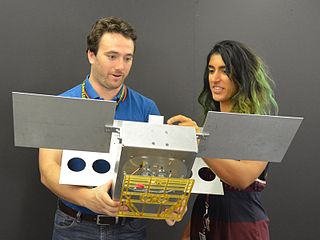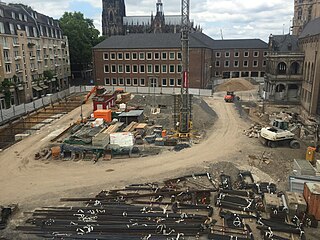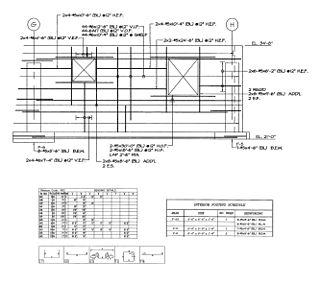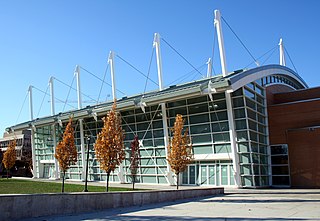Related Research Articles

An architect is a person who plans, designs and oversees the construction of buildings. To practice architecture means to provide services in connection with the design of buildings and the space within the site surrounding the buildings that have human occupancy or use as their principal purpose. Etymologically, the term architect derives from the Latin architectus, which derives from the Greek, i.e., chief builder.

Engineers, as practitioners of engineering, are professionals who invent, design, analyze, build and test machines, complex systems, structures, gadgets and materials to fulfill functional objectives and requirements while considering the limitations imposed by practicality, regulation, safety and cost. The word engineer is derived from the Latin words ingeniare and ingenium ("cleverness"). The foundational qualifications of a licensed professional engineer typically include a four-year bachelor's degree in an engineering discipline, or in some jurisdictions, a master's degree in an engineering discipline plus four to six years of peer-reviewed professional practice and passage of engineering board examinations.

Construction is a general term meaning the art and science of forming objects, systems, or organizations. It comes from the Latin word constructio and Old French construction. To 'construct' is a verb: the act of building, and the noun is construction: how something is built or the nature of its structure.
A project manager is a professional in the field of project management. Project managers have the responsibility of the planning, procurement and execution of a project, in any undertaking that has a defined scope, defined start and a defined finish; regardless of industry. Project managers are first point of contact for any issues or discrepancies arising from within the heads of various departments in an organization before the problem escalates to higher authorities, as project representative.

In systems engineering, information systems and software engineering, the systems development life cycle (SDLC), also referred to as the application development life cycle, is a process for planning, creating, testing, and deploying an information system. The SDLC concept applies to a range of hardware and software configurations, as a system can be composed of hardware only, software only, or a combination of both. There are usually six stages in this cycle: requirement analysis, design, development and testing, implementation, documentation, and evaluation.
In architecture, a project architect (PA) is the individual who is responsible for overseeing the architectural aspects of the development of a design, production of the construction documents (plans), and specifications. The position generally involves coordinating the needs of a client, possibly and designer and technical staff, and outside consultants such as structural, civil, and mechanical engineers, as well as interior designers and landscape architects.
Design–bid–build, also known as Design–tender, traditional method, or hardbid, is a project delivery method in which the agency or owner contracts with separate entities for the design and construction of a project.
A design engineer is an engineer focused on the engineering design process in any of the various engineering disciplines and design disciplines like Human-Computer Interaction. Design engineers tend to work on products and systems that involve adapting and using complex scientific and mathematical techniques. The emphasis tends to be on utilizing engineering physics and other applied sciences to develop solutions for society.
Construction management (CM) aims to control the quality of a project's scope, time, and cost to maximize the project owner's satisfaction. It uses project management techniques and software to oversee the planning, design, construction and closeout of a construction project safely, on time, on budget and within specifications.

A shop drawing is a drawing or set of drawings produced by the contractor, supplier, manufacturer, subcontractor, consultants, or fabricator. Shop drawings are typically required for prefabricated components. Examples of these include: elevators, structural steel, trusses, pre-cast concrete, windows, appliances, cabinets, air handling units, and millwork. Also critical are the installation and coordination shop drawings of the MEP trades such as sheet metal ductwork, piping, plumbing, fire protection, and electrical. Shop drawings are produced by contractors and suppliers under their contract with the owner. The shop drawing is the manufacturer’s or the contractor’s drawn version of information shown in the construction documents. The shop drawing normally shows more detail than the construction documents. It is drawn to explain the fabrication and/or installation of the items to the manufacturer’s production crew or contractor's installation crews. The style of the shop drawing is usually very different from that of the architect’s drawing. The shop drawing’s primary emphasis is on the particular product or installation and excludes notation concerning other products and installations, unless integration with the subject product is necessary.
Project engineering includes all parts of the design of manufacturing or processing facilities, either new or modifications to and expansions of existing facilities. A "project" consists of a coordinated series of activities or tasks performed by engineers, designers, drafters and others from one or more engineering disciplines or departments. Project tasks consist of such things as performing calculations, writing specifications, preparing bids, reviewing equipment proposals and evaluating or selecting equipment and preparing various lists, such as equipment and materials lists, and creating drawings such as electrical, piping and instrumentation diagrams, physical layouts and other drawings used in design and construction. A small project may be under the direction of a project engineer. Large projects are typically under the direction of a project manager or management team. Some facilities have in house staff to handle small projects, while some major companies have a department that does internal project engineering. Large projects are typically contracted out to engineering companies. Staffing at engineering companies varies according to the work load and duration of employment may only last until an individual's tasks are completed.
In construction, commissioning or commissioning process is an integrated, systematic process to ensure, through documented verification, that all building systems perform interactively according to the "Design Intent". The commissioning process establishes and documents the "Owner's Project Requirements (OPR)" criteria for system function, performance expectations, maintainability; verify and document compliance with these criteria throughout all phases of the project. Commissioning procedures require a collaborative team effort and 'should' begin during the pre-design or planning phase of the project, continue through the design and construction phases, initial occupancy phase, training of operations and maintenance (O&M) staff, and into occupancy.

A drafter is an engineering technician who makes detailed technical drawings or plans for machinery, buildings, electronics, infrastructure, sections, etc. Drafters use computer software and manual sketches to convert the designs, plans, and layouts of engineers and architects into a set of technical drawings. Drafters operate as the supporting developers and sketch engineering designs and drawings from preliminary design concepts.

Architectural engineering or architecture engineering, also known as building engineering, is a discipline that deals with the engineering and construction of buildings, such as structural, mechanical, electrical, lighting, environmental, climate control, telecommunications, security, and other areas. It is related to both architecture and civil engineering, and distinguished from architectural design, as an art and science of designing buildings.

Project commissioning is the process of ensuring that all systems and components of a building or industrial plant are designed, installed, tested, operated, and maintained according to the owner's or final client's operational requirements. A commissioning process may be applied not only to new projects but also to existing units and systems subject to expansion, renovation or revamping.
Front-End Engineering (FEE), or Front-End Engineering Design (FEED), is an engineering design approach used to control project expenses and thoroughly plan a project before a fix bid quote is submitted. It may also be referred to as Pre-project planning (PPP), front-end loading (FEL), feasibility analysis, or early project planning.
Technical Integrity Engineering, also known as Asset Integrity, involves various engineering disciplines that focus on making sure a product, process, or system meets its intended requirements when it's used. Applying these disciplines to reduce costs, maintain schedules, manage technical risks, and handle legal concerns during a project's entire life cycle ensures operations run smoothly and safely in industries like Oil and Gas, Power Generation, and Nuclear Power. This helps plants work efficiently, stay safe, and deal with challenges like hazards effectively.
Geoprofessions is a term coined by the Geoprofessional Business Association to connote various technical disciplines that involve engineering, earth and environmental services applied to below-ground ("subsurface"), ground-surface, and ground-surface-connected conditions, structures, or formations. The principal disciplines include, as major categories:
Pre-construction services are services that are offered to support owners, architects, and engineers in making decisions. They are used in planning a construction project before the actual construction begins. The stage where these services are offered is called pre-construction or "pre-con".
An independent engineer, also known as a lender's engineer, is a term often given to the engineering representative of the lender, or financier, of a large capital project. The key is to be independent so that opinions on the technical aspects of the project are not biased either in favor of the lenders or the developer/owners. To maintain independence, the independent engineer is typically selected by the lender but paid by the developer/owner.
References
- 1 2 3 "Owner's Engineer Services". Tüv Süd. 2024. Retrieved February 2, 2024.
- ↑ Ivins, Rick. "Independent Engineering Versus Owner's Engineering". www.purepower.com. Retrieved 2024-02-02.